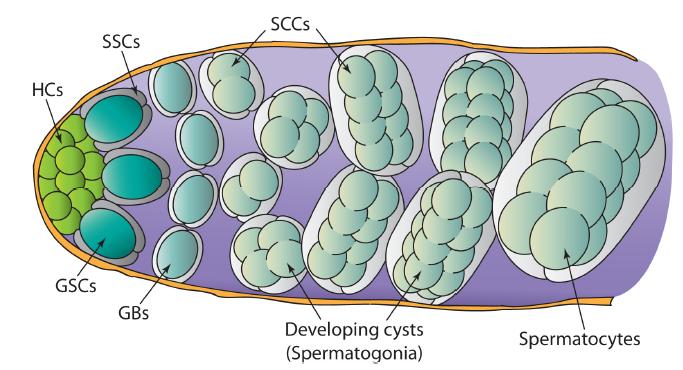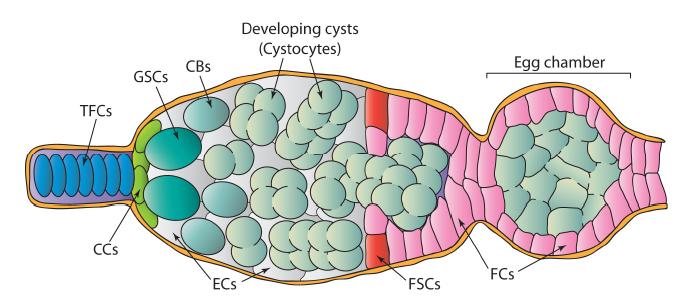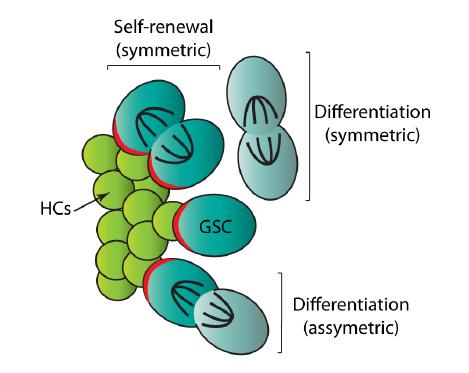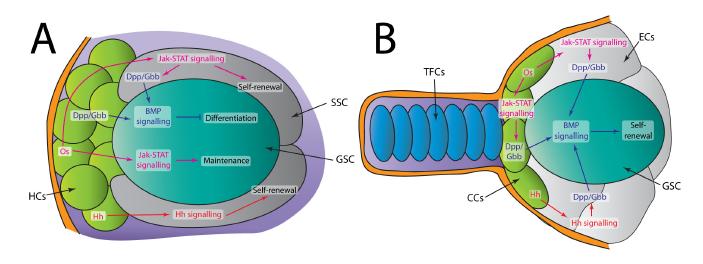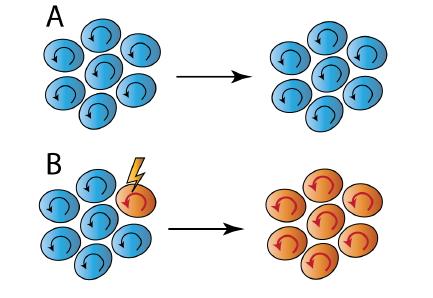|
[1]
|
Schofield R (1978) The relationship between the spleen colony-forming cell and the haemopoietic stem cell. Blood Bells 4: 7-25.
|
|
[2]
|
Hardy R, Tokuyasu K, Lindsley D, et al. (1979) The Germinal Proliferation Center in the Testis of Drosophila melanogaster. J Ultrastructure Res 69: 180-190. doi: 10.1016/S0022-5320(79)90108-4

|
|
[3]
|
Wieschaus E, Szabad J (1979) The Development and Function of the Female Germ Line in Drosophila melanogaster: A Cell Lineage Study. Dev Biol 68: 29-46. doi: 10.1016/0012-1606(79)90241-0

|
|
[4]
|
Fuller M (1993) Spermatogenesis. In: Bate M, Martinez Arias A, editors. The Development of Drosophila melanogaster: Cold Spring Harbor Laboratory Press. pp. 71-147.
|
|
[5]
|
Spradling AC (1993) Developmental genetics of oogenesis. In: Bate M, Martinez Arias A, editors. The Development of Drosophila melanogaster: Cold Spring Harbor Laboratory Press. pp. 1-70.
|
|
[6]
|
Kiger AA, White-Cooper H, Fuller MT (2000) Somatic support cells restrict germline stem cell self-renewal and promote differentiation. Nature 407: 750-754. doi: 10.1038/35037606

|
|
[7]
|
Tran J, Brenner TJ, DiNardo S (2000) Somatic control over the germline stem cell lineage during Drosophila spermatogenesis. Nature 407: 754-757. doi: 10.1038/35037613

|
|
[8]
|
Xie T, Spradling AC (2000) A Niche Maintaining Germ Line Stem Cells in the Drosophila Ovary. Science 290: 328-330. doi: 10.1126/science.290.5490.328

|
|
[9]
|
Li L, Xie T (2005) Stem Cell Niche: Structure and Function. Annual Review of Cell and Dev Biol 21: 605-631. doi: 10.1146/annurev.cellbio.21.012704.131525

|
|
[10]
|
Morrison SJ, Spradling AC (2008) Stem Cells and Niches: Mechanisms That Promote Stem Cell Maintenance Throughout Life. Cell 132: 598-611. doi: 10.1016/j.cell.2008.01.038

|
|
[11]
|
Rezza A, Sennett R, Rendl M (2014) Adult Stem Cell Niches: Cellular and Molecular Components. In: Rendl M, editor. Stem Cells in Development and Disease: Academic Press. pp. 333.
|
|
[12]
|
Xie T (2008) Germline stem cell niches. In: Lin H, Donahoe P, editors. StemBook: StemBook.
|
|
[13]
|
Reya T, Morrison SJ, Clarke MF, et al. (2001) Stem cells, cancer, and cancer stem cells. Nature 414: 105-111. doi: 10.1038/35102167

|
|
[14]
|
White AC, Lowry WE (2014) Refining the role for adult stem cells as cancer cells of origin. Trends Cell Biol.
|
|
[15]
|
Yamashita YM, Jones DL, Fuller MT (2003) Orientation of Asymmetric Stem Cell Division by the APC Tumor Suppressor and Centrosome. Science 301: 1547-1550. doi: 10.1126/science.1087795

|
|
[16]
|
Sheng XR, Matunis E (2011) Live imaging of the Drosophila spermatogonial stem cell niche reveals novel mechanisms regulating germline stem cell output. Development 138: 3367-3376. doi: 10.1242/dev.065797

|
|
[17]
|
Decotto E, Spradling AC (2005) The Drosophila Ovarian and Testis Stem Cell Niches: Similar Somatic Stem Cells and Signals. Dev Cell 9: 501-510. doi: 10.1016/j.devcel.2005.08.012

|
|
[18]
|
Morris LX, Spradling AC (2011) Long-term live imaging provides new insight into stem cell regulation and germline-soma coordination in the Drosophila ovary. Development 138: 2207-2215. doi: 10.1242/dev.065508

|
|
[19]
|
Margolis J, Spradling A (1995) Identification and behavior of epithelial stem cells in the Drosophila ovary. Development 121: 3797-3807.
|
|
[20]
|
Nystul T, Spradling A (2007) An Epithelial Niche in the Drosophila Ovary Undergoes Long-Range Stem Cell Replacement. Cell Stem Cell 1: 277-285. doi: 10.1016/j.stem.2007.07.009

|
|
[21]
|
Vied C, Reilein A, Field NS, et al. (2012) Regulation of Stem Cells by Intersecting Gradients of Long-Range Niche Signals. Dev Cell 23: 836-848. doi: 10.1016/j.devcel.2012.09.010

|
|
[22]
|
Sahai-Hernandez P, Nystul TG (2013) A dynamic population of stromal cells contributes to the follicle stem cell niche in the Drosophila ovary. Development 140: 4490-4498. doi: 10.1242/dev.098558

|
|
[23]
|
Bastock R, St Johnston D (2008) Drosophila oogenesis. Curr Biol 18: R1082-R1087. doi: 10.1016/j.cub.2008.09.011

|
|
[24]
|
Shahriyari L, Komarova NL (2013) Symmetric vs. Asymmetric Stem Cell Divisions: An Adaptation against Cancer? PloS One 8: e76195.
|
|
[25]
|
Huttner WB, Kosodo Y (2005) Symmetric versus asymmetric cell division during neurogenesis in the developing vertebrate central nervous system. Curr Opin Cell Biol 17: 648-657. doi: 10.1016/j.ceb.2005.10.005

|
|
[26]
|
Kosodo Y, Röper K, Haubensak W, et al. (2004) Asymmetric distribution of the apical plasma membrane during neurogenic divisions of mammalian neuroepithelial cells. EMBO J 23: 2314-2324. doi: 10.1038/sj.emboj.7600223

|
|
[27]
|
Yamashita YM, Mahowald AP, Perlin JR, et al. (2007) Asymmetric Inheritance of Mother Versus Daughter Centrosome in Stem Cell Division. Science 315: 518-521. doi: 10.1126/science.1134910

|
|
[28]
|
Venkei ZG, Yamashita YM (2015) The centrosome orientation checkpoint is germline stem cell specific and operates prior to the spindle assembly checkpoint in Drosophila testis. Development 142.
|
|
[29]
|
Gonzalez C (2007) Spindle orientation, asymmetric division and tumour suppression in Drosophila stem cells. Nat Rev Genet 8: 462-472. doi: 10.1038/nrg2103

|
|
[30]
|
Deng W, Lin H (1997) Spectrosomes and Fusomes Anchor Mitotic Spindles during Asymmetric Germ Cell Divisions and Facilitate the Formation of a Polarized Microtubule Array for Oocyte Specification in Drosophila. Dev Biol 189: 79-94. doi: 10.1006/dbio.1997.8669

|
|
[31]
|
Roth S, Lynch JA (2009) Symmetry Breaking During Drosophila Oogenesis. Cold Spring Harb Perspect Biol 1: a001891.
|
|
[32]
|
Lu W, Casanueva MO, Mahowald AP, et al. (2012) Niche-Associated Activation of Rac Promotes the Asymmetric Division of Drosophila Female Germline Stem Cells. PLoS Biol 10: e1001357. doi: 10.1371/journal.pbio.1001357

|
|
[33]
|
Salzmann V, Chen C, Chiang C-YA, et al. (2014) Centrosome-dependent asymmetric inheritance of the midbody ring in Drosophila germline stem cell division. Mol Biol Cell 25: 267-275. doi: 10.1091/mbc.E13-09-0541

|
|
[34]
|
Izumi H, Kaneko Y (2012) Evidence of asymmetric cell division and centrosome inheritance in human neuroblastoma cells. PNAS 109: 18048-18053. doi: 10.1073/pnas.1205525109

|
|
[35]
|
Yadlapalli S, Yamashita YM (2013) Chromosome-specific nonrandom sister chromatid segregation during stem-cell division. Nature 498: 251-254. doi: 10.1038/nature12106

|
|
[36]
|
Tran V, Lim C, Xie J, et al. (2012) Asymmetric Division of Drosophila Male Germline Stem Cell Shows Asymmetric Histone Distribution. Science 338: 679-682. doi: 10.1126/science.1226028

|
|
[37]
|
Clayton E, Doupé DP, Klein AM, et al. (2007) A single type of progenitor cell maintains normal epidermis. Nature 446: 185-189. doi: 10.1038/nature05574

|
|
[38]
|
Doupé DP, Klein AM, Simons BD, et al. (2010) The Ordered Architecture of Murine Ear Epidermis is Maintained by Progenitor Cells with Random Fate. Dev Cell 18: 317-323. doi: 10.1016/j.devcel.2009.12.016

|
|
[39]
|
Klein AM, Nakagawa T, Ichikawa R, et al. (2010) Mouse Germ Line Stem Cells Undergo Rapid and Stochastic Turnover. Cell Stem Cell 7: 214-224. doi: 10.1016/j.stem.2010.05.017

|
|
[40]
|
Lopez-Garcia C, Klein AM, Simons BD, et al. (2010) Intestinal Stem Cell Replacement Follows a Pattern of Neutral Drift. Science 330: 822-825. doi: 10.1126/science.1196236

|
|
[41]
|
Snippert HJ, Van Der Flier LG, Sato T, et al. (2010) Intestinal Crypt Homeostasis Results from Neutral Competition between Symmetrically Dividing Lgr5 Stem Cells. Cell 143: 134-144. doi: 10.1016/j.cell.2010.09.016

|
|
[42]
|
Yatabe Y, Tavaré S, Shibata D (2001) Investigating stem cells in human colon by using methylation patterns. PNAS 98: 10839-10844. doi: 10.1073/pnas.191225998

|
|
[43]
|
Kleinsmith LJ, Pierce GB (1964) Multipotentiality of Single Embryonal Carcinoma Cells. Cancer Res 24: 1544-1551.
|
|
[44]
|
Pierce GB, Wallace C (1971) Differentiation of Malignant to Benign Cells. Cancer Res 31: 127-134.
|
|
[45]
|
Cheng C-W, Adams GB, Perin L, et al. (2014) Prolonged Fasting Reduces IGF-1/PKA to Promote Hematopoietic-Stem-Cell-Based Regeneration and Reverse Immunosuppression. Cell Stem Cell 14: 810-823. doi: 10.1016/j.stem.2014.04.014

|
|
[46]
|
Wicha MS (2014) Targeting self-renewal, an Achilles' heel of cancer stem cells. Nat Med 20: 14-15. doi: 10.1038/nm.3434

|
|
[47]
|
Wicha MS, Liu S, Dontu G (2006) Cancer Stem Cells: An Old Idea - A Paradigm Shift. Cancer Res 66: 1883-1890. doi: 10.1158/0008-5472.CAN-05-3153

|
|
[48]
|
Nguyen LV, Vanner R, Dirks P, et al. (2012) Cancer stem cells: an evolving concept. Nat Rev Cancer 12: 133-143.
|
|
[49]
|
Calò V, Migliavacca M, Bazan V, et al. (2003) STAT Proteins: From Normal Control of Cellular Events to Tumorigenesis. J Cell Physiol 197: 157-168. doi: 10.1002/jcp.10364

|
|
[50]
|
Devarajan E, Huang S (2009) STAT3 as a Central Regulator of Tumor Metastases. Curr Mol Med 9: 626-633. doi: 10.2174/156652409788488720

|
|
[51]
|
Dutta P, Li WX (2013) Role of the JAK‐STAT Signalling Pathway in Cancer. eLS.
|
|
[52]
|
Yu H, Lee H, Herrmann A, et al. (2014) Revisiting STAT3 signalling in cancer: new and unexpected biological functions. Nat Rev Cancer 14: 736-746. doi: 10.1038/nrc3818

|
|
[53]
|
Johnston PA, Grandis JR (2011) STAT3 Signaling: Anticancer Strategies and Challenges. Mol Interventions 11: 18. doi: 10.1124/mi.11.1.4

|
|
[54]
|
Terry NA, Tulina N, Matunis E, et al. (2006) Novel regulators revealed by profiling Drosophila testis stem cells within their niche. Dev Biol 294: 246-257. doi: 10.1016/j.ydbio.2006.02.048

|
|
[55]
|
Tulina N, Matunis E (2001) Control of Stem Cell Self-Renewal in Drosophila Spermatogenesis by JAK-STAT Signaling. Science 294: 2546-2549. doi: 10.1126/science.1066700

|
|
[56]
|
Kiger AA, Jones DL, Schulz C, et al. (2001) Stem Cell Self-Renewal Specified by JAK-STAT Activation in Response to a Support Cell Cue. Science 294: 2542-2545. doi: 10.1126/science.1066707

|
|
[57]
|
Flaherty MS, Salis P, Evans CJ, et al. (2010) chinmo Is a Functional Effector of the JAK/STAT Pathway that Regulates Eye Development, Tumor Formation, and Stem Cell Self-Renewal in Drosophila. Dev Cell 18: 556-568. doi: 10.1016/j.devcel.2010.02.006

|
|
[58]
|
Leatherman JL, DiNardo S (2008) Zfh-1 Controls Somatic Stem Cell Self-Renewal in the Drosophila Testis and Nonautonomously Influences Germline Stem Cell Self-Renewal. Cell Stem Cell 3: 44-54. doi: 10.1016/j.stem.2008.05.001

|
|
[59]
|
Leatherman JL, DiNardo S (2010) Germline self-renewal requires cyst stem cells and stat regulates niche adhesion in Drosophila testes. Nat Cell Biol 12: 806-811. doi: 10.1038/ncb2086

|
|
[60]
|
López-Onieva L, Fernández-Miñán A, González-Reyes A (2008) Jak/Stat signalling in niche support cells regulates dpp transcription to control germline stem cell maintenance in the Drosophila ovary. Development 135: 533-540. doi: 10.1242/dev.016121

|
|
[61]
|
Wang L, Li Z, Cai Y (2008) The JAK/STAT pathway positively regulates DPP signaling in the Drosophila germline stem cell niche. J Cell Biol 180: 721-728. doi: 10.1083/jcb.200711022

|
|
[62]
|
Massagué J, Blain SW, Lo RS (2000) TGFβ Signaling in Growth Control, Cancer, and Heritable Disorders. Cell 103: 295-309. doi: 10.1016/S0092-8674(00)00121-5

|
|
[63]
|
Varga AC, Wrana JL (2005) The disparate role of BMP in stem cell biology. Oncogene 24: 5713-5721. doi: 10.1038/sj.onc.1208919

|
|
[64]
|
Kawase E, Wong MD, Ding BC, et al. (2004) Gbb/Bmp signaling is essential for maintaining germline stem cells and for repressing bam transcription in the Drosophila testis. Development 131: 1365-1375. doi: 10.1242/dev.01025

|
|
[65]
|
Song X, Wong MD, Kawase E, et al. (2004) Bmp signals from niche cells directly repress transcription of a differentiation-promoting gene, bag of marbles, in germline stem cells in the Drosophila ovary. Development 131: 1353-1364. doi: 10.1242/dev.01026

|
|
[66]
|
Shivdasani AA, Ingham PW (2003) Regulation of Stem Cell Maintenance and Transit Amplifying Cell Proliferation by TGF-β Signaling in Drosophila Spermatogenesis. Curr Biol 13: 2065-2072. doi: 10.1016/j.cub.2003.10.063

|
|
[67]
|
Chen D, McKearin D (2003) Dpp Signaling Silences bam Transcription Directly to Establish Asymmetric Divisions of Germline Stem Cells. Curr Biol 13: 1786-1791. doi: 10.1016/j.cub.2003.09.033

|
|
[68]
|
Insco ML, Leon A, Tam CH, et al. (2009) Accumulation of a differentiation regulator specifies transit amplifying division number in an adult stem cell lineage. PNAS 106: 22311-22316. doi: 10.1073/pnas.0912454106

|
|
[69]
|
Xie T, Spradling AC (1998) decapentaplegic Is Essential for the Maintenance and Division of Germline Stem Cells in the Drosophila Ovary. Cell 94: 251-260. doi: 10.1016/S0092-8674(00)81424-5

|
|
[70]
|
Casanueva MO, Ferguson EL (2004) Germline stem cell number in the Drosophila ovary is regulated by redundant mechanisms that control Dpp signaling. Development 131: 1881-1890. doi: 10.1242/dev.01076

|
|
[71]
|
Xia L, Jia S, Huang S, et al. (2010) The Fused/Smurf Complex Controls the Fate of Drosophila Germline Stem Cells by Generating a Gradient BMP Response. Cell 143: 978-990. doi: 10.1016/j.cell.2010.11.022

|
|
[72]
|
Schulz C, Kiger AA, Tazuke SI, et al. (2004) A Misexpression Screen Reveals Rffects of bag-of-marbles and TGFβ Class Signaling on the Drosophila Male Germ-Line Stem Cell Lineage. Genetics 167: 707-723. doi: 10.1534/genetics.103.023184

|
|
[73]
|
Kitadate Y, Kobayashi S (2010) Notch and Egfr signaling act antagonistically to regulate germ-line stem cell niche formation in Drosophila male embryonic gonads. PNAS 107: 14241-14246. doi: 10.1073/pnas.1003462107

|
|
[74]
|
Okegbe TC, DiNardo S (2011) The endoderm specifies the mesodermal niche for the germline in Drosophila via Delta-Notch signaling. Development 138: 1259-1267. doi: 10.1242/dev.056994

|
|
[75]
|
Song X, Call GB, Kirilly D, et al. (2007) Notch signaling controls germline stem cell niche formation in the Drosophila ovary. Development 134: 1071-1080. doi: 10.1242/dev.003392

|
|
[76]
|
Ward EJ, Shcherbata HR, Reynolds SH, et al. (2006) Stem Cells Signal to the Niche through the Notch Pathway in the Drosophila Ovary. Curr Biol 16: 2352-2358. doi: 10.1016/j.cub.2006.10.022

|
|
[77]
|
Beachy PA, Karhadkar SS, Berman DM (2004) Tissue repair and stem cell renewal in carcinogenesis. Nature 432: 324-331. doi: 10.1038/nature03100

|
|
[78]
|
Schüller U, Heine VM, Mao J, et al. (2008) Acquisition of Granule Neuron Precursor Identity is a Critical Determinant of Progenitor Cell Competence to Form Shh-Induced Medulloblastoma. Cancer Cell 14: 123-134. doi: 10.1016/j.ccr.2008.07.005

|
|
[79]
|
Yang Z-J, Ellis T, Markant SL, et al. (2008) Medulloblastoma Can Be Initiated by Deletion of Patched in Lineage-Restricted Progenitors or Stem Cells. Cancer Cell 14: 135-145. doi: 10.1016/j.ccr.2008.07.003

|
|
[80]
|
Hahn H, Wicking C, Zaphiropoulos PG, et al. (1996) Mutations of the Human Homolog of Drosophila patched in the Nevoid Basal Cell Carcinoma Syndrome. Cell 85: 841-851. doi: 10.1016/S0092-8674(00)81268-4

|
|
[81]
|
Johnson RL, Rothman AL, Xie J, et al. (1996) Human Homolog of patched, a Candidate Gene for the Basal Cell Nevus Syndrome. Science 272: 1668-1671. doi: 10.1126/science.272.5268.1668

|
|
[82]
|
Youssef KK, Van Keymeulen A, Lapouge G, et al. (2010) Identification of the cell lineage at the origin of basal cell carcinoma. Nat Cell Biol 12: 299-305.
|
|
[83]
|
Ingham P (1998) Transducing Hedgehog: the story so far. EMBO J 17: 3505-3511. doi: 10.1093/emboj/17.13.3505

|
|
[84]
|
Amoyel M, Sanny J, Burel M, et al. (2013) Hedgehog is required for CySC self-renewal but does not contribute to the GSC niche in the Drosophila testis. Development 140: 56-65. doi: 10.1242/dev.086413

|
|
[85]
|
Michel M, Kupinski AP, Raabe I, et al. (2012) Hh signalling is essential for somatic stem cell maintenance in the Drosophila testis niche. Development 139: 2663-2669. doi: 10.1242/dev.075242

|
|
[86]
|
Zhang Z, Lv X, Jiang J, et al. (2013) Dual roles of Hh signaling in the regulation of somatic stem cell self-renewal and germline stem cell maintenance in Drosophila testis. Cell Res 23: 573.
|
|
[87]
|
Rojas-Ríos P, Guerrero I, González-Reyes A (2012) Cytoneme-Mediated Delivery of Hedgehog Regulates the Expression of Bone Morphogenetic Proteins to Maintain Germline Stem Cells in Drosophila. PLoS Biol 10: e1001298.
|
|
[88]
|
Zhang Y, Kalderon D (2001) Hedgehog acts as a somatic stem cell factor in the Drosophila ovary. Nature 410: 599-604. doi: 10.1038/35069099

|
|
[89]
|
Schwitalla S, Fingerle AA, Cammareri P, et al. (2013) Intestinal Tumorigenesis Initiated by Dedifferentiation and Acquisition of Stem-Cell-like Properties. Cell 152: 25-38. doi: 10.1016/j.cell.2012.12.012

|
|
[90]
|
Kai T, Spradling A (2004) Differentiating germ cells can revert into functional stem cells in Drosophila melanogaster ovaries. Nature 428: 564-569. doi: 10.1038/nature02436

|
|
[91]
|
Brawley C, Matunis E (2004) Regeneration of Male Germline Stem Cells by Spermatogonial Dedifferentiation in Vivo. Science 304: 1331-1334. doi: 10.1126/science.1097676

|
|
[92]
|
Sheng XR, Brawley CM, Matunis EL (2009) Dedifferentiating Spermatogonia Outcompete Somatic Stem Cells for Niche Occupancy in the Drosophila Testis. Cell Stem Cell 5: 191-203. doi: 10.1016/j.stem.2009.05.024

|
|
[93]
|
Xing Y, Kurtz I, Thuparani M, et al. (2012) Loss-of-Function Screen Reveals Novel Regulators Required for Drosophila Germline Stem Cell Self-Renewal. G3: Genes| Genomes| Genetics 2: 343-351.
|
|
[94]
|
Yan D, Neumüller RA, Buckner M, et al. (2014) A Regulatory Network of Drosophila Germline Stem Cell Self-Renewal. Dev Cell 28: 459-473. doi: 10.1016/j.devcel.2014.01.020

|
|
[95]
|
Kai T, Williams D, Spradling AC (2005) The expression profile of purified Drosophila germline stem cells. Dev Biol 283: 486-502. doi: 10.1016/j.ydbio.2005.04.018

|
|
[96]
|
Zhao R, Xi R (2010) Stem Cell Competition for Niche Occupancy: Emerging Themes and Mechanisms. Stem Cell Rev 6: 345-350. doi: 10.1007/s12015-010-9128-3

|
|
[97]
|
Morrissey ER, Vermeulen L (2014) Stem cell competition: how speeding mutants beat the rest. EMBO J: e201489823.
|
|
[98]
|
Vincent J-P, Fletcher AG, Baena-Lopez LA (2013) Mechanisms and mechanics of cell competition in epithelia. Nat Rev Mol Cell Biol 14: 581-591. doi: 10.1038/nrm3639

|
|
[99]
|
Wagstaff L, Kolahgar G, Piddini E (2013) Competitive cell interactions in cancer: a cellular tug of war. Trends Cell Biol 23: 160-167. doi: 10.1016/j.tcb.2012.11.002

|
|
[100]
|
Baker A-M, Cereser B, Melton S, et al. (2014) Quantification of Crypt and Stem Cell Evolution in the Normal and Neoplastic Human Colon. Cell Rep 8: 940-947. doi: 10.1016/j.celrep.2014.07.019

|
|
[101]
|
Issigonis M, Tulina N, de Cuevas M, et al. (2009) JAK-STAT Signal Inhibition Regulates Competition in the Drosophila Testis Stem Cell Niche. Science 326: 153-156. doi: 10.1126/science.1176817

|
|
[102]
|
Singh SR, Zheng Z, Wang H, et al. (2010) Competitiveness for the Niche and Mutual Dependence of the Germline and Somatic Stem Cells in the Drosophila Testis are Regulated by the JAK/STAT Signaling. J Cell Physiol 223: 500-510.
|
|
[103]
|
Kronen MR, Schoenfelder KP, Klein AM, et al. (2014) Basolateral Junction Proteins Regulate Competition for the Follicle Stem Cell Niche in the Drosophila Ovary. PloS One 9: e101085. doi: 10.1371/journal.pone.0101085

|
|
[104]
|
Nystul T, Spradling A (2010) Regulation of Epithelial Stem Cell Replacement and Follicle Formation in the Drosophila Ovary. Genetics 184: 503-515. doi: 10.1534/genetics.109.109538

|
|
[105]
|
Jin Z, Kirilly D, Weng C, et al. (2008) Differentiation-Defective Stem Cells Outcompete Normal Stem Cells for Niche Occupancy in the Drosophila Ovary. Cell Stem Cell 2: 39-49. doi: 10.1016/j.stem.2007.10.021

|
|
[106]
|
Rhiner C, Díaz B, Portela M, et al. (2009) Persistent competition among stem cells and their daughters in the Drosophila ovary germline niche. Development 136: 995-1006. doi: 10.1242/dev.033340

|
|
[107]
|
Amoyel M, Simons BD, Bach EA (2014) Neutral competition of stem cells is skewed by proliferative changes downstream of Hh and Hpo. EMBO J.
|
|
[108]
|
Huang J, Kalderon D (2014) Coupling of Hedgehog and Hippo pathways promotes stem cell maintenance by stimulating proliferation. J Cell Biol : jcb. 201309141.
|
|
[109]
|
Inaba M, Yuan H, Salzmann V, et al. (2010) E-cadherin Is Required for Centrosome and Spindle Orientation in Drosophila Male Germline Stem Cells. PLoS One 5: e12473. doi: 10.1371/journal.pone.0012473

|
|
[110]
|
Tanentzapf G, Devenport D, Godt D, et al. (2007) Integrin-dependent anchoring of a stem-cell niche. Nat Cell Biol 9: 1413-1418. doi: 10.1038/ncb1660

|
|
[111]
|
Michel M, Raabe I, Kupinski AP, et al. (2011) Local BMP receptor activation at adherens junctions in the Drosophila germline stem cell niche. Nature Commun 2: 415. doi: 10.1038/ncomms1426

|
|
[112]
|
Song X, Zhu C-H, Doan C, et al. (2002) Germline Stem Cells Anchored by Adherens Junctions in the Drosophila Ovary Niches. Science 296: 1855-1857. doi: 10.1126/science.1069871

|
|
[113]
|
Song X, Xie T (2002) DE-cadherin-mediated cell adhesion is essential for maintaining somatic stem cells in the Drosophila ovary. PNAS 99: 14813-14818. doi: 10.1073/pnas.232389399

|
|
[114]
|
Caussinus E, Gonzalez C (2005) Induction of tumor growth by altered stem-cell asymmetric division in Drosophila melanogaster. Nat Genet 37: 1125-1129. doi: 10.1038/ng1632

|
|
[115]
|
Januschke J, Gonzalez C (2008) Drosophila asymmetric division, polarity and cancer. Oncogene 27: 6994-7002. doi: 10.1038/onc.2008.349

|
|
[116]
|
Marthiens V, Kazanis I, Moss L, et al. (2010) Adhesion molecules in the stem cell niche–more than just staying in shape? J Cell Sci 123: 1613-1622. doi: 10.1242/jcs.054312

|
|
[117]
|
Li D, Zhou J, Wang L, et al. (2010) Integrated biochemical and mechanical signals regulate multifaceted human embryonic stem cell functions. J Cell Biol 191: 631-644. doi: 10.1083/jcb.201006094

|
|
[118]
|
Li L, Bennett S, Wang L (2012) Role of E-cadherin and other cell adhesion molecules in survival and differentiation of human pluripotent stem cells. Cell Adhes Migr 6: 59-70. doi: 10.4161/cam.19583

|
|
[119]
|
Canel M, Serrels A, Frame MC, et al. (2013) E-cadherin–integrin crosstalk in cancer invasion and metastasis. J Cell Sci 126: 393-401. doi: 10.1242/jcs.100115

|
|
[120]
|
Wang D, Su L, Huang D, et al. (2011) Downregulation of E-Cadherin enhances proliferation of head and neck cancer through transcriptional regulation of EGFR. Mol Cancer 10: 1-10. doi: 10.1186/1476-4598-10-1

|
|
[121]
|
Stockinger A, Eger A, Wolf J, et al. (2001) E-cadherin regulates cell growth by modulating proliferation-dependent β-catenin transcriptional activity. J Cell Biol 154: 1185-1196. doi: 10.1083/jcb.200104036

|
|
[122]
|
Shen R, Weng C, Yu J, et al. (2009) eIF4A controls germline stem cell self-renewal by directly inhibiting BAM function in the Drosophila ovary. PNAS 106: 11623-11628. doi: 10.1073/pnas.0903325106

|
|
[123]
|
Chen H, Chen X, Zheng Y (2013) The Nuclear Lamina Regulates Germline Stem Cell Niche Organization via Modulation of EGFR Signaling. Cell Stem cell 13: 73-86. doi: 10.1016/j.stem.2013.05.003

|
|
[124]
|
Hudson AG, Parrott BB, Qian Y, et al. (2013) A Temporal Signature of Epidermal Growth Factor Signaling Regulates the Differentiation of Germline Cells in Testes of Drosophila melanogaster. PloS One 8: e70678. doi: 10.1371/journal.pone.0070678

|
|
[125]
|
Parrott BB, Hudson A, Brady R, et al. (2012) Control of Germline Stem Cell Division Frequency - A Novel, Developmentally Regulated Role for Epidermal Growth Factor Signaling. PloS One 7: e36460. doi: 10.1371/journal.pone.0036460

|
|
[126]
|
Sarkar A, Parikh N, Hearn SA, et al. (2007) Antagonistic Roles of Rac and Rho in Organizing the Germ Cell Microenvironment. Curr Biol 17: 1253-1258. doi: 10.1016/j.cub.2007.06.048

|
|
[127]
|
Schulz C, Wood CG, Jones DL, et al. (2002) Signaling from germ cells mediated by the rhomboid homolog stet organizes encapsulation by somatic support cells. Development 129: 4523-4534.
|
|
[128]
|
Sander EE, Jean P, van Delft S, et al. (1999) Rac Downregulates Rho Activity Reciprocal Balance between Both GTPases Determines Cellular Morphology and Migratory Behavior. J Cell Biol 147: 1009-1022. doi: 10.1083/jcb.147.5.1009

|
|
[129]
|
Joti P, Ghosh-Roy A, Ray K (2011) Dynein light chain 1 functions in somatic cyst cells regulate spermatogonial divisions in Drosophila. Scientific Reports 1.
|
|
[130]
|
Papagiannouli F (2014) Male stem Cell Niche and Spermatogenesis in the Drosophila testis - A Tale of Germline-Soma Communication. In: Wislet-Gendebien S, editor. Adult Stem Cell Niches: InTech.
|
|
[131]
|
Humbert P, Grzeschik N, Brumby A, et al. (2008) Control of tumourigenesis by the Scribble/Dlg/Lgl polarity module. Oncogene 27: 6888-6907. doi: 10.1038/onc.2008.341

|
|
[132]
|
Papagiannouli F, Mechler BM (2009) discs large regulates somatic cyst cell survival and expansion in Drosophila testis. Cell Res 19: 1139-1149. doi: 10.1038/cr.2009.71

|
|
[133]
|
Papagiannouli F (2013) The internal structure of embryonic gonads and testis development in Drosophila melanogaster requires scrib, lgl and dlg activity in the soma. Int J Dev Biol 57: 25-34. doi: 10.1387/ijdb.120087fp

|
|
[134]
|
Bilder D, Li M, Perrimon N (2000) Cooperative Regulation of Cell Polarity and Growth by Drosophila Tumor Suppressors. Science 289: 113-116. doi: 10.1126/science.289.5476.113

|
|
[135]
|
Eliassen AH, Hankinson SE (2008) Endogenous Hormone Levels and Risk of Breast, Endometrial and Ovarian Cancers: Prospective Studies. In: Berstein L, Santen R, editors. Innovative Endocrinology of Cancer: Landes Bioscience and Springer Media+Business Media. pp. 148-165.
|
|
[136]
|
Henderson BE, Ross RK, Pike MC, et al. (1982) Endogenous Hormones as a Major Factor in Human Cancer. Cancer Res 42: 3232-3239.
|
|
[137]
|
Liang J, Shang Y (2013) Estrogen and Cancer. Annu Rev Physiol 75: 225-240. doi: 10.1146/annurev-physiol-030212-183708

|
|
[138]
|
Clemons M, Goss P (2001) Estrogen and the Risk of Breast Cancer. New Engl J Med 344: 276-285. doi: 10.1056/NEJM200101253440407

|
|
[139]
|
Yager JD, Davidson NE (2006) Estrogen Carcinogenesis in Breast Cancer. New Engl J Med 354: 270-282. doi: 10.1056/NEJMra050776

|
|
[140]
|
Ziel HK (1982) Estrogen's role in endometrial cancer. Obstet Gynecol 60: 509-515.
|
|
[141]
|
Derwahl M, Nicula D (2014) Estrogen and its role in thyroid cancer. Endocr Relat Cancer 21: T273-T283. doi: 10.1530/ERC-14-0053

|
|
[142]
|
D’Errico I, Moschetta A (2008) Nuclear receptors, intestinal architecture and colon cancer: an intriguing link. Cell and Mol Life Sci 65: 1523-1543. doi: 10.1007/s00018-008-7552-1

|
|
[143]
|
Bosland MC (2000) The Role of Steroid Hormones in Prostate Carcinogenesis. J Natl Cancer Inst Monographs 2000: 39-66. doi: 10.1093/oxfordjournals.jncimonographs.a024244

|
|
[144]
|
Nakada D, Oguro H, Levi BP, et al. (2014) Oestrogen increases haematopoietic stem-cell self-renewal in females and during pregnancy. Nature 505: 555-558. doi: 10.1038/nature12932

|
|
[145]
|
De Loof A (2006) Ecdysteroids: the overlooked sex steroids of insects? Males: the black box. Insect Sci 13: 325-338.
|
|
[146]
|
Bownes M (1982) The role of 20-hydroxy-ecdysone in yolk-polypeptide synthesis by male and female fat bodies of Drosophila melanogaster. J Insect Physiol 28: 317-328. doi: 10.1016/0022-1910(82)90043-9

|
|
[147]
|
Koelle MR, Talbot WS, Segraves WA, et al. (1991) The Drosophila EcR Gene Encodes an Ecdysone Receptor, a New Member of the Steroid Receptor Superfamily. Cell 67: 59-77. doi: 10.1016/0092-8674(91)90572-G

|
|
[148]
|
Yao T-P, Segraves WA, Oro AE, et al. (1992) Drosophila ultraspiracle Modulates Ecdysone Receptor Function via Heterodimer Formation. Cell 71: 63-72. doi: 10.1016/0092-8674(92)90266-F

|
|
[149]
|
Anzick SL, Kononen J, Walker RL, et al. (1997) AIB1, a Steroid Receptor Coactivator Amplified in Breast and Ovarian Cancer. Science 277: 965-968. doi: 10.1126/science.277.5328.965

|
|
[150]
|
Bai J, Uehara Y, Montell DJ (2000) Regulation of Invasive Cell Behavior by Taiman, a Drosophila Protein Related to AIB1, a Steroid Receptor Coactivator Amplified in Breast Cancer. Cell 103: 1047-1058. doi: 10.1016/S0092-8674(00)00208-7

|
|
[151]
|
Buszczak M, Freeman MR, Carlson JR, et al. (1999) Ecdysone response genes govern egg chamber development during mid-oogenesis in Drosophila. Development 126: 4581-4589.
|
|
[152]
|
Carney GE, Bender M (2000) The Drosophila ecdysone receptor (EcR) Gene Is Required Maternally for Normal Oogenesis. Genetics 154: 1203-1211.
|
|
[153]
|
Hackney JF, Pucci C, Naes E, et al. (2007) Ras Signaling Modulates Activity of the Ecdysone Receptor EcR During Cell Migration in the Drosophila Ovary. Dev Dynam 236: 1213-1226. doi: 10.1002/dvdy.21140

|
|
[154]
|
Terashima J, Bownes M (2006) E75A and E75B have opposite effects on the apoptosis/development choice of the Drosophila egg chamber. Cell Death Differ 13: 454-464. doi: 10.1038/sj.cdd.4401745

|
|
[155]
|
Terashima J, Takaki K, Sakurai S, et al. (2005) Nutritional status affects 20-hydroxyecdysone concentration and progression of oogenesis in Drosophila melanogaster. J Endocrinologyogy 187: 69-79. doi: 10.1677/joe.1.06220

|
|
[156]
|
Ables ET, Drummond-Barbosa D (2010) The Steroid Hormone Ecdysone Functions with Intrinsic Chromatin Remodeling Factors to Control Female Germline Stem Cells in Drosophila. Cell Stem Cell 7: 581-592. doi: 10.1016/j.stem.2010.10.001

|
|
[157]
|
Xi R, Xie T (2005) Stem Cell Self-Renewal Controlled by Chromatin Remodeling Factors. Science 310: 1487-1489. doi: 10.1126/science.1120140

|
|
[158]
|
König A, Yatsenko AS, Weiss M, et al. (2011) Ecdysteroids affect Drosophila ovarian stem cell niche formation and early germline differentiation. EMBO J 30: 1549-1562. doi: 10.1038/emboj.2011.73

|
|
[159]
|
Morris LX, Spradling AC (2012) Steroid Signaling Within Drosophila Ovarian Epithelial Cells Sex-Specifically Modulates Early Germ Cell Development and Meiotic Entry. PloS One 7: e46109. doi: 10.1371/journal.pone.0046109

|
|
[160]
|
Qian Y, Dominado N, Zoller R, et al. (2014) Ecdysone signaling opposes epidermal growth factor signaling in regulating cyst differentiation in the male gonad of Drosophila melanogaster. Dev Biol 394: 217-227. doi: 10.1016/j.ydbio.2014.08.019

|
|
[161]
|
Li Y, Ma Q, Cherry CM, et al. (2014) Steroid signaling promotes stem cell maintenance in the Drosophila testis. Dev Biol 394: 129-141. doi: 10.1016/j.ydbio.2014.07.016

|
|
[162]
|
Drummond-Barbosa D, Spradling AC (2001) Stem Cells and Their Progeny Respond to Nutritional Changes during Drosophila Oogenesis. Dev Biol 231: 265-278. doi: 10.1006/dbio.2000.0135

|
|
[163]
|
Hétié P, de Cuevas M, Matunis E (2014) Conversion of Quiescent Niche Cells to Somatic Stem Cells Causes Ectopic Niche Formation in the Drosophila Testis. Cell Rep 7: 715-721. doi: 10.1016/j.celrep.2014.03.058

|
|
[164]
|
Voog J, Sandall SL, Hime GR, et al. (2014) Escargot Restricts Niche Cell to Stem Cell Conversion in the Drosophila Testis. Cell Rep 7: 722-734. doi: 10.1016/j.celrep.2014.04.025

|
|
[165]
|
Longo VD, Fontana L (2010) Calorie restriction and cancer prevention: metabolic and molecular mechanisms. Trends Pharmacol Sci 31: 89-98. doi: 10.1016/j.tips.2009.11.004

|
|
[166]
|
McLeod CJ, Wang L, Wong C, et al. (2010) Stem Cell Dynamics in Response to Nutrient Availability. Curr Biol 20: 2100-2105. doi: 10.1016/j.cub.2010.10.038

|
|
[167]
|
Wang L, McLeod C, Jones DL (2011) Regulation of adult stem cell behavior by nutrient signaling. Cell Cycle 10: 2628-2634. doi: 10.4161/cc.10.16.17059

|
|
[168]
|
Hsu H-J, LaFever L, Drummond-Barbosa D (2008) Diet controls normal and tumorous germline stem cells via insulin-dependent and -independent mechanisms in Drosophila. Dev Biol 313: 700-712. doi: 10.1016/j.ydbio.2007.11.006

|
|
[169]
|
LaFever L, Drummond-Barbosa D (2005) Direct Control of Germline Stem Cell Division and Cyst Growth by Neural Insulin in Drosophila. Science 309: 1071-1073. doi: 10.1126/science.1111410

|
|
[170]
|
Roth TM, Chiang C-YA, Inaba M, et al. (2012) Centrosome misorientation mediates slowing of the cell cycle under limited nutrient conditions in Drosophila male germline stem cells. Mol Biol Cell 23: 1524-1532. doi: 10.1091/mbc.E11-12-0999

|
|
[171]
|
Ueishi S, Shimizu H, H. Inoue Y (2009) Male Germline Stem Cell Division and Spermatocyte Growth Require Insulin Signaling in Drosophila. Cell Struct Funct 34: 61-69. doi: 10.1247/csf.08042

|
|
[172]
|
Hsu H-J, Drummond-Barbosa D (2009) Insulin levels control female germline stem cell maintenance via the niche in Drosophila. PNAS 106: 1117-1121. doi: 10.1073/pnas.0809144106

|
|
[173]
|
Hsu H-J, Drummond-Barbosa D (2011) Insulin signals control the competence of the Drosophila female germline stem cell niche to respond to Notch ligands. Dev Biol 350: 290-300. doi: 10.1016/j.ydbio.2010.11.032

|
|
[174]
|
Gallagher EJ, LeRoith D (2011) Minireview: IGF, Insulin, and Cancer. Endocrinology 152: 2546-2551. doi: 10.1210/en.2011-0231

|
|
[175]
|
Downward J (2003) Targeting RAS signalling pathways in cancer therapy. Nat Rev Cancer 3: 11-22. doi: 10.1038/nrc969

|
|
[176]
|
Nicholson R, Gee J, Harper M (2001) EGFR and cancer prognosis. Eur J Cancer 37: 9-15.
|
|
[177]
|
Yarden Y (2001) The EGFR family and its ligands in human cancer: signalling mechanisms and therapeutic opportunities. Eur J Cancer 37: 3-8.
|
|
[178]
|
Guo Z, Wang Z (2009) The glypican Dally is required in the niche for the maintenance of germline stem cells and short-range BMP signaling in the Drosophila ovary. Development 136: 3627-3635. doi: 10.1242/dev.036939

|
|
[179]
|
Liu M, Lim TM, Cai Y (2010) The Drosophila Female Germline Stem Cell Lineage Acts to Spatially Restrict DPP Function Within the Niche. Sci Signal 3: ra57.
|
|
[180]
|
Hayashi Y, Kobayashi S, Nakato H (2009) Drosophila glypicans regulate the germline stem cell niche. J Cell Biol 187: 473-480. doi: 10.1083/jcb.200904118

|
|
[181]
|
Li C-Y, Guo Z, Wang Z (2007) TGFβ receptor saxophone non-autonomously regulates germline proliferation in a Smox/dSmad2-dependent manner in Drosophila testis. Dev Biol 309: 70-77. doi: 10.1016/j.ydbio.2007.06.019

|
|
[182]
|
Matunis E, Tran J, Gonczy P, et al. (1997) punt and schnurri regulate a somatically derived signal that restricts proliferation of committed progenitors in the germline. Development 124: 4383-4391.
|
|
[183]
|
Boyle M, Wong C, Rocha M, et al. (2007) Decline in Self-Renewal Factors Contributes to Aging of the Stem Cell Niche in the Drosophila Testis. Cell Stem Cell 1: 470-478. doi: 10.1016/j.stem.2007.08.002

|
|
[184]
|
Pan L, Chen S, Weng C, et al. (2007) Stem Cell Aging Is Controlled Both Intrinsically and Extrinsically in the Drosophila Ovary. Cell Stem Cell 1: 458-469. doi: 10.1016/j.stem.2007.09.010

|
|
[185]
|
Cheng J, Türkel N, Hemati N, et al. (2008) Centrosome misorientation reduces stem cell division during ageing. Nature 456: 599-604. doi: 10.1038/nature07386

|
|
[186]
|
Inaba M, Yuan H, Yamashita YM (2011) String (Cdc25) regulates stem cell maintenance, proliferation and aging in Drosophila testis. Development 138: 5079-5086. doi: 10.1242/dev.072579

|
|
[187]
|
Jones PA, Baylin SB (2002) The fundamental role of epigenetic events in cancer. Nat Rev Genet 3: 415-428.
|
|
[188]
|
Casper AL, Baxter K, Van Doren M (2011) no child left behind encodes a novel chromatin factor required for germline stem cell maintenance in males but not females. Development 138: 3357-3366. doi: 10.1242/dev.067942

|
|
[189]
|
Cherry CM, Matunis EL (2010) Epigenetic Regulation of Stem Cell Maintenance in the Drosophila Testis via the Nucleosome-Remodeling Factor NURF. Cell Stem Cell 6: 557-567. doi: 10.1016/j.stem.2010.04.018

|
|
[190]
|
Eun SH, Shi Z, Cui K, et al. (2014) A Non–Cell Autonomous Role of E(z) to Prevent Germ Cells from Turning on a Somatic Cell Marker. Science 343: 1513-1516. doi: 10.1126/science.1246514

|
|
[191]
|
Tarayrah L, Herz H-M, Shilatifard A, et al. (2013) Histone demethylase dUTX antagonizes JAK-STAT signaling to maintain proper gene expression and architecture of the Drosophila testis niche. Development 140: 1014-1023. doi: 10.1242/dev.089433

|
|
[192]
|
Yang SY, Baxter EM, Van Doren M (2012) Phf7 Controls Male Sex Determination in the Drosophila Germline. Dev Cell 22: 1041-1051. doi: 10.1016/j.devcel.2012.04.013

|
|
[193]
|
He J, Xuan T, Xin T, et al. (2014) Evidence for Chromatin-Remodeling Complex PBAP-Controlled Maintenance of the Drosophila Ovarian Germline Stem Cells. PloS One 9: e103473. doi: 10.1371/journal.pone.0103473

|
|
[194]
|
Xin T, Xuan T, Tan J, et al. (2013) The Drosophila putative histone acetyltransferase Enok maintains female germline stem cells through regulating Bruno and the niche. Dev Biol 384: 1-12. doi: 10.1016/j.ydbio.2013.10.001

|
|
[195]
|
Xuan T, Xin T, He J, et al. (2013) dBre1/dSet1-dependent pathway for histone H3K4 trimethylation has essential roles in controlling germline stem cell maintenance and germ cell differentiation in the Drosophila ovary. Dev Biol 379: 167-181. doi: 10.1016/j.ydbio.2013.04.015

|
|
[196]
|
Xie T (2013) Control of germline stem cell self-renewal and differentiation in the Drosophila ovary: concerted actions of niche signals and intrinsic factors. WIREs Dev Biol 2: 261-273. doi: 10.1002/wdev.60

|
|
[197]
|
Matunis EL, Stine RR, de Cuevas M (2012) Recent advances in Drosophila male germline stem cell biology. Spermatogenesis 2: 137-144. doi: 10.4161/spmg.21763

|
|
[198]
|
Zoller R, Schulz C (2012) The Drosophila cyst stem cell lineage. Spermatogenesis 2.
|
|
[199]
|
Harvey KF, Zhang X, Thomas DM (2013) The Hippo pathway and human cancer. Nat Rev Cancer 13: 246-257. doi: 10.1038/nrc3458

|
|
[200]
|
Hall CA, Wang R, Miao J, et al. (2010) Hippo Pathway Effector Yap is an Ovarian Cancer Oncogene. Cancer Res 70: 8517-8525. doi: 10.1158/0008-5472.CAN-10-1242

|
|
[201]
|
Issigonis M, Matunis E (2012) The Drosophila BCL6 homolog ken and barbie promotes somatic stem cell self-renewal in the testis niche. Dev Biol 368: 181-192. doi: 10.1016/j.ydbio.2012.04.034

|
|
[202]
|
Pasqualucci L, Bereschenko O, Niu H, et al. (2003) Molecular Pathogenesis of Non-Hodgkin's Lymphoma: the Role of Bcl-6. Leukemia Lymphoma 44: S5-S12.
|
|
[203]
|
Resende LPF, Boyle M, Tran D, et al. (2013) Headcase Promotes Cell Survival and Niche Maintenance in the Drosophila Testis. PloS One 8: e68026. doi: 10.1371/journal.pone.0068026

|
|
[204]
|
Makino N, Yamato T, Inoue H, et al. (2001) Isolation and Characterization of the Human Gene Homologous to the Drosophila headcase (hdc) Gene in Chromosome Bands 6q23-q24, a Region of Common Deletion in Human Pancreatic Cancer. Mitochondr DNA 11: 547-553. doi: 10.3109/10425170109041340

|
|
[205]
|
Montell DJ, Yoon WH, Starz-Gaiano M (2012) Group choreography: mechanisms orchestrating the collective movement of border cells. Nat Rev Mol Cell Biol 13: 631-645. doi: 10.1038/nrm3433

|
|
[206]
|
Rosales-Nieves AE, González-Reyes A. Genetics and mechanisms of ovarian cancer: Parallels between Drosophila and humans; 2014. Elsevier. pp. 104-109.
|
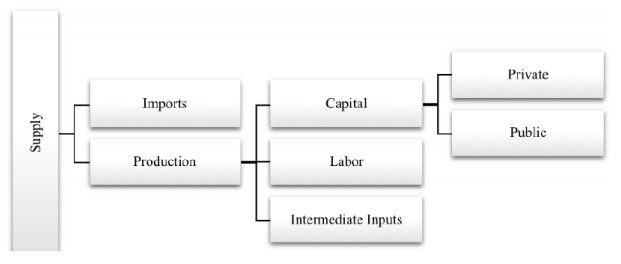









 DownLoad:
DownLoad:


